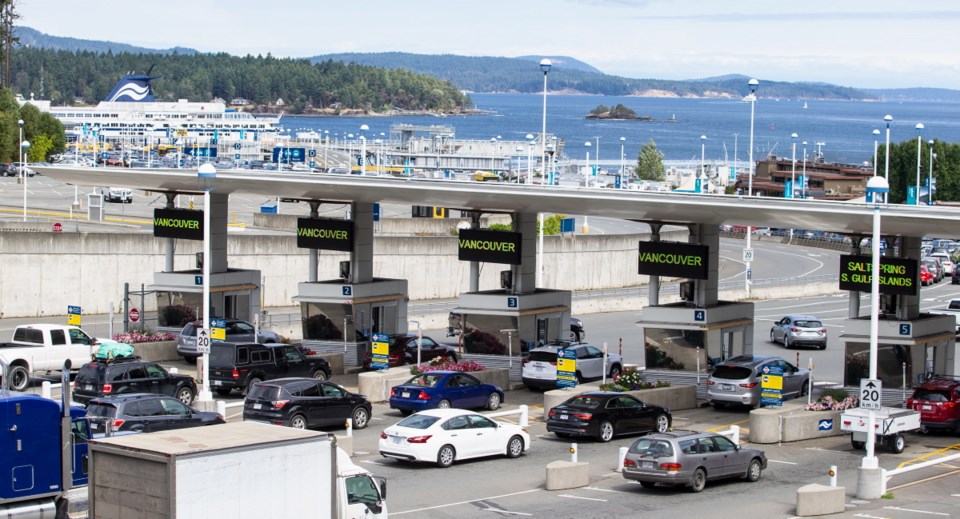 I saw them catch a queue-jumper at the Tsawwassen ferry terminal last week.
I saw them catch a queue-jumper at the Tsawwassen ferry terminal last week.
The driver had tried sneaking out of a going-nowhere lane and into one that was boarding. Fortunately, before he got too far, a couple of B.C. Ferries workers wrenched open his door, dragged him squealing onto the pavement, lit him up with a Taser and threw his keys into the saltchuck.
Well, no, what they did was hold him in place, steam pouring out of his ears (or perhaps his radiator) as the rest of us squeezed into the last few spaces on the Coastal Perspiration. I’m not sure what happened after that, though I like to think the car was towed to the back of the lot and set on fire while the driver was tranquillized, ear-tagged and relocated to a Walmart parking lot in Surrey.
For this, dear reader, is the truth: Nobody likes a budger.
This is particularly true at the terminals, where the whole process — up to 400 vehicles and 2,100 people pouring off a ferry, then a similar number pouring on, all within 25 minutes — depends on order.
Keeping that order depends on ferry users playing by the rules, which, in turn, depends on faith. Faith that vehicles will be loaded fairly. Faith that everybody will wait their turn. Faith that if they don’t, somebody will stop them.
Happily, that faith is rewarded. Indeed, if the justice system operated like B.C. Ferries, we wouldn’t have to lock our doors at night. It is comforting to know that in a world in which court delays allow drug dealers to walk free, phone scammers prey on the elderly with impunity and lamentably few of us still bother to call 911 to report abuse of the Nine Items or Less rule at the check-out, high in the clouds above the ferry terminal, an all-seeing god sits ready to wield the sword of justice with swift, unblinking certainty should anyone attempt to butt in line.
That god’s name is Ed.
At least, it was this week, when Ed Gravonic was one of two B.C. Ferries employees working the tower at the Swartz Bay terminal. I went there with Camrin Hillis, the B.C. Ferries regional manager, to see how they go about keeping order at the terminals.
Here’s what I learned: First, the tower enjoys a view high-priced executives would kill for, but the focus is on the parking lot. Split-screen television monitors offer more views, video images captured by the 100-plus surveillance cameras dotted around the terminal. (“I’ve seen people walk chickens on a leash around the dog park,” Gravonic says.) Computer screens track which vehicles are in which lane, and which ones are supposed to be sent on board first.
Here’s how they load vehicles: Those with reservations get priority, but must be there at least 30 minutes before sailing. Don’t worry that the guy with Saskatchewan plates in front of you is taking forever to buy his ticket, appears to be asking directions or trying to order a Big Mac or something. As long as you’re in the ticket booth lineup before that 30-minute cut-off, the agent will let you through.
Then there are the people with assured-loading tickets. The tickets cost a lot — $1,550 for a book of 10 — but they can be used like instant reservations (or a Disneyland Fastpass) as long as the user shows up at least 20 minutes before departure time.
After that there’s the great herd of us, the standbys. “All the standby traffic is boarded in the order they arrived,” Hillis says. It doesn’t matter whether you are lined up with the overheight vehicles or are over with the underheights, if the sailing is full, the last spot should go to whoever bought their ticket first.
This can be determined with the help of a digital time stamp: Every single car in line is monitored. One click of the mouse and the tower operator can tell how many occupants are supposed to be in it and when they paid for their ticket.
Gravonic also jots down a description of the last vehicle in each line, which is a good way to spot queue-jumpers. If the black pickup that should be last is followed by another car, chances are the latter is butting in.
Lane-jumping occurs fairly often during busy periods. “If it doesn’t happen one sailing, it will happen the next,” Gravonic says.
Be warned, though. If caught butting in, you will be punished, prevented from boarding until others have gone. Sometimes that means holding you in place while others load, but if there’s enough time, you’ll be Snakes and Laddered to the back of the line to wait there.
Sometimes Gravonic or someone like him will boom it out from the public address system: “You in the red van in lane 11, go to the end of lane 15.” Then the van will do the Drive of Shame as other ferry users whistle, clap and offer one-fingered encouragement. To repeat: Nobody likes a budger.
Seasoned travellers are the least likely to lane-jump. Gulf Islanders in particular know better than to try it; even if they escape the scrutiny of B.C. Ferries staff, they risk being seen and ostracized by their neighbours.
The irony is that there often is no need to try to elbow to the front. “We say ‘Why didn’t you stay there? You would have made it,’ ” Gravonic says.
Some budgers profess ignorance when stopped. Some feel shame. Some bluster: “Where does it say on the ticket that I’m not allowed to lane-jump,” a man once demanded of Gravonic.
Getting mad at B.C. Ferries staff won’t help your cause, though. “Abusive behaviour is not acceptable,” Hillis says. Persist and you might be denied passage altogether.
Lane-jumpers aren’t the only ones who have to worry. So do those sports teams that decide to party in the parking lot while waiting for the ferry. Gravonic saw that happen early last Monday afternoon: “Down came the tailgate and out came the beers.” That’s when the terminal manager will intervene, perhaps even calling the cops to test the sobriety of the driver.
There are also those who pull onto the shoulder of the highway to hide passengers before they reach the ticket booth, just like the old days at the drive-in movies. Alas for them, those in other vehicles will often rat them out to the ticket agent. Ferry users have a low tolerance for rule-breakers..



